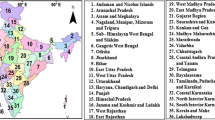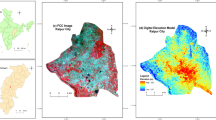Abstract
Two years of in situ radon concentration measurements in the atmospheric surface layer have been collected in a central Italy town (L’Aquila), located in the Aterno river valley. These data have been analyzed in order to study the controlling mechanisms of surface radon abundance; observations of coincident meteorological parameters confirmed the role of dynamics on the local removal rate of this tracer. The relatively high negative correlation of hourly data of surface wind speed and radon activity concentration (R = −0.54, on annual scale) suggests that dynamical removal of radon is one of the most important controlling processes of the tracer accumulation in the atmospheric surface layer. An attempt is made to quantify the precipitation impact on radon soil fluxes. No anticorrelation of radon and precipitation comes out from the data (R = −0.15), as in previous studies. However, since the main physical parameter affecting the ground radon release is expected to be the soil accumulation of water, snow or ice, the emission flux has also been correlated with soil moisture; in this way a much clearer anticorrelation is found (R = −0.54).





Similar content being viewed by others
References
Allen DJ, Rood RB, Thompson AM, Hudson RD (1996) Three-dimensional radon-222 calculations using assimilated meteorological data and a convective mixing algorithm. J Geophys Res 101:6871–6881
Allen RG, Pruitt WO, Wright JL, Howell TA, Ventura F, Snyder R, Itenfisu D, Steduto P, Berengena J, Yrisarry JB, Smith M, Pereira LS, Raes D, Perrier A, Alves I, Walter I, Elliott R (2006) A recommendation on standardized surface resistance for hourly calculation of reference ETO by the FAO56 Penman–Monteith method. Agric Water Manage 81:1–22
Considine DB, Bergmann DJ, Liu H (2005) Sensitivity of global modeling initiative chemistry and transport model simulations of radon-222 and lead-210 to input meteorological data. Atmos Chem Phys 5:3389–3406
Dentener F, Feichter J, Jeuken A (1999) Simulation of the transport of Rn-222 using on-line and off-line global models at different horizontal resolutions: a detailed comparison with measurements. Tellus 51B:573–602
Di Carlo P, Pitari G, Mancini E, Gentile S, Pichelli E, Visconti G (2007) Evolution of surface ozone in central Italy based on observations and statistical model, J Geophys Res 112:D10316. doi:10.1029/2006JD007900
Galmarini S (2006) One year of 222-Rn concentration in the atmospheric surface layer. Atmos Chem Phys 6:2865–2887
Gaudry A, Polian G, Ardouin B, Lambert G (1990) Radon-calibrated emissions of CO2 from South Africa. Tellus 42:9–19
Genthon C, Armengaud A (1995) Radon-222 as a comparative tracer of transport and mixing in 2 general-circulation models of the atmosphere. J Geophys Res 100:2849–2866
Ishimori Y, Ito K, Furuta S (1998) Environmental effect of radon from Uranium waste rock piles: Part I—measurements by passive and continuous monitors, in: Proceedings of the 7th Tohwa University international symposium on radon and thoron in the human environment, edited by: Katase A and Shimo M, 23–25 October 1997, Fukouka, Japan
Israel H, Horbert M (1966) Results of continuous measurements of radon and its decay products in the lower atmosphere. Tellus 18(2):638–641
Jacob DJ, Prather MJ (1990) Radon-222 as a test of convective transport in a general circulation model. Tellus 42B:118–134
Jacob DJ, Prather MJ, Rasch PJ, Shia RL, Balkanski YJ, Beagley SR, Bergmann DJ, Blackshear WT, Brown M, Chiba M, Chipperfield MP, de Grandpre J, Dignon JE, Feichter J, Genthon C, Grose WL, Kasibhatla PS, Kohler I, Kritz MA, Law K, Penner JE, Ramonet M, Reeves CE, Rotman DA, Stockwell DZ, VanVelthoven PFJ, Verver G, Wild O, Yang H, Zimmermann P (1997) Evaluation and intercomparison of global atmospheric transport models using Rn-222 and other short-lived tracers. J Geophys Res 102:5953–5970
Josse B, Simon P, Peuch VH (2004) Radon global simulations with the multiscale chemistry and transport model MOCAGE. Tellus 56B:339–356
Kataoka T, Yunoki E, Shimizu M, Mori T (1998) Diurnal variation in radon concentration and mixing-layer depth. Bound Layer Meteorol 89:225–250
Sesana L, Barbieri L, Facchini U, Marcazzan GM (1998) 222Rn as a tracer of atmospheric motions: a study in Milan. Radiat Prot Dosimetry 78:65–71
Lee HN, Feichter J (1996) An intercomparison of wet precipitation scavenging schemes and the emission rates of Rn-222 for the simulation of global transport and deposition of Pb-210. J Geophys Res 100(D11) 23: 253–270
Li YH, Chang JS (1996) A three-dimensional global episodic tracer transport model. 1. Evaluation of its processes by radon 222 simulations. J Geophys Res 101(25):931–947
Mahowald NM, Rasch PJ, Eaton BE, Whittlestone S, Prinn RG (1997) Transport of (222)radon to the remote troposphere using the model of atmospheric transport and chemistry and assimilated winds from ECMWF and the National Center for Environmental Prediction NCAR. J Geophys Res 28:139–151
Megumi K, Mamuro T (1973) Radon and Thoron exhalation from the ground. J Geophys Res 78(11):1804–1808
Monks PS (2000) A review of the observations and origins of the spring ozone maximum. Atmos Environ 34:3545–3561
Ramonet M, Le Roulley JC, Bousquet P, Monfray P (1996) Radon-222 measurements during the Tropoz II campaign and comparison with a global atmospheric transport model. J Atmos Chem 23:107–136
Stockwell DZ, Kritz MA, Chipperfield MP, Pyle JA (1998) Validation of an off-line three dimensional chemical transport model using observed radon profiles—2. Model results. J Geophys Res 103:8433–8445
US Soil Conservation Service: National Engineering Handbook, Part 630 (2004) Hydrology, Soil Conservation Service, USDA, Washington, DC
Vinod Kumar A, Sitaraman V, Oza RB, Krishamoorthy TM (1999) Application of a numerical model for the planetary boundary layer to the vertical distribution of radon and its daughter products. Atmos Environ 33:4717–4726
Zahorowski W, Chambers SD, Henderson-Sellers A (2004) Ground based radon-222 observations and their application to atmospheric studies. J Environ Radact 76:3–33
Acknowledgments
We thank the Center of Excellence CETEMPS for partially supporting this research. Many students of the Environmental Science and Physics courses of the University of L’Aquila have given some contributions in the early stage of instruments setup and data acquisition. We also thank Marco Verdecchia for stimulating discussions about soil moisture.
Author information
Authors and Affiliations
Corresponding author
Rights and permissions
About this article
Cite this article
Carlo, P.D., Pitari, G., De Luca, N. et al. Observations of surface radon in Central Italy. Environ Geol 58, 431–436 (2009). https://doi.org/10.1007/s00254-008-1513-8
Received:
Accepted:
Published:
Issue Date:
DOI: https://doi.org/10.1007/s00254-008-1513-8




